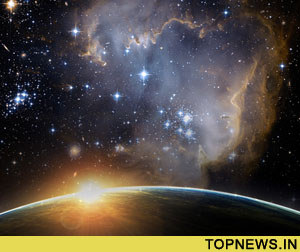The Universe is flat, but not entirely
 London, May 19 : In a move that is reminiscent of scientists rejecting the view held by many people in the medieval times that the Earth is flat, a team of researchers has dismissed the notion that the Universe is completely flat.
London, May 19 : In a move that is reminiscent of scientists rejecting the view held by many people in the medieval times that the Earth is flat, a team of researchers has dismissed the notion that the Universe is completely flat.
According to a report in New Scientist, when it comes to the universe, "flatness" refers to the fate of light beams traveling large distances parallel to each other.
If the universe is "flat", the beams will always remain parallel. Matter, energy and dark energy all produce curvature in space-time, however.
If the universe's space-time is positively curved, like the surface of a sphere, parallel beams would come together. In a negatively curved, saddle-shaped universe, parallel beams would diverge.
Thanks in part to the Wilkinson Microwave Anisotropy Probe (WMAP) satellite, which revealed the density of matter and dark energy in the early universe, most astronomers are confident that the universe is flat.
But, that view is now being questioned by Joseph Silk at the University of Oxford and colleagues, who say it's possible that the WMAP observations have been misinterpreted.
In a research paper accepted for publication in Monthly Notices of the Royal Astronomical Society, they took data from WMAP and other cosmology experiments and analyzed it using Bayes's theorem, which can be used to show how the certainty attached to a particular conclusion is affected by different starting assumptions.
Using modern astronomers' assumptions, which presuppose a flat universe, they calculated the probability that the universe was in one of three states: flat, positively curved or negatively curved.
This produced a 98 per cent probability that the universe is indeed flat.
When they reran the calculation starting from a more open-minded position, however, the probability changed to 67 per cent, making a flat universe far less of a certainty than astronomers generally conclude.
"It's a reasonable assumption that the universe isn't entirely flat," Silk said, adding that the calculation reveals how strongly astronomers' prejudices can affect their conclusions.
"They've developed a statistically rigorous way of examining the question," said David Spergel of Princeton University, the spokesman for WMAP.
According to Silk, astronomers need to achieve a 99.9999 per cent level of confidence on the flat universe, high enough that the case starts to look compelling no matter what the starting assumptions are.
It's possible, however, that no measurements will ever be able to get to that level of accuracy. (ANI)